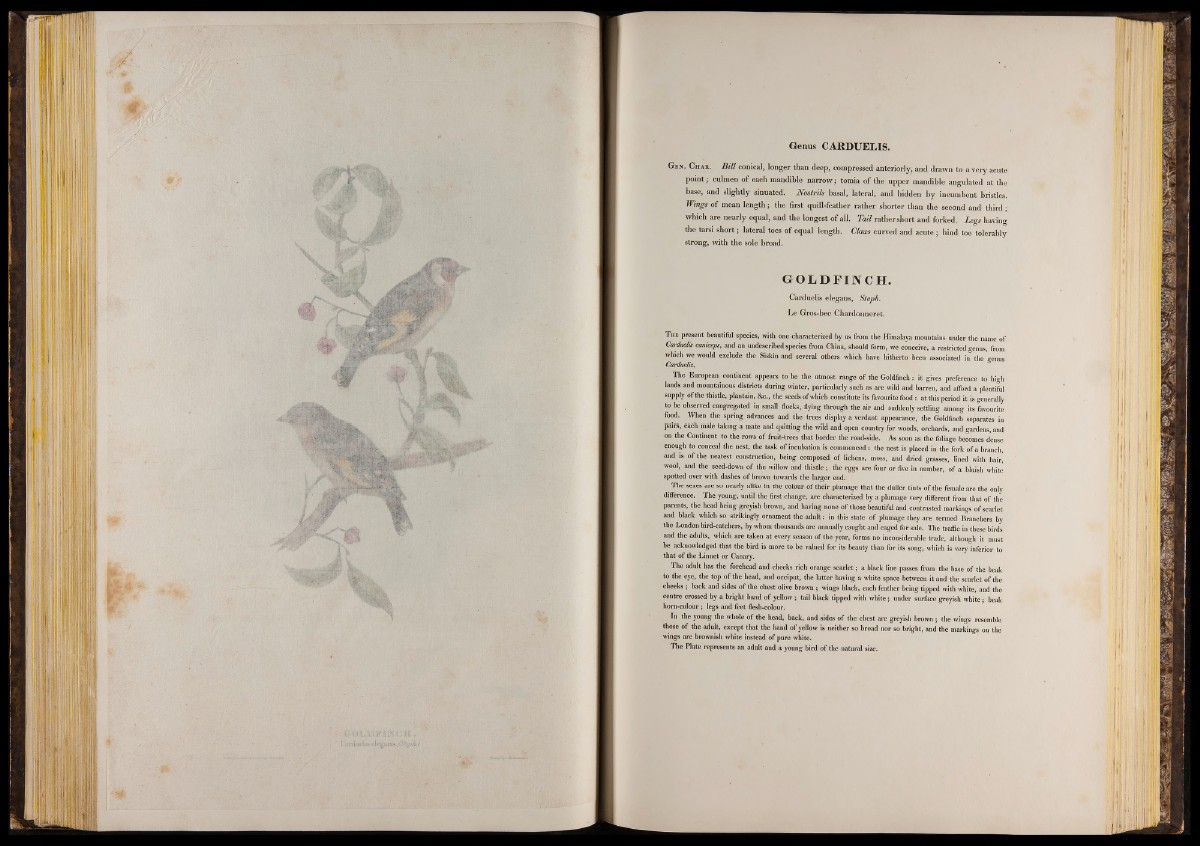
Genus CARDUELIS.
G en . Char. B i l l conical, longer than deep, compressed anteriorly, and drawn to a very acute
p o in t; culmen o f each mandible narrow; tomia o f the upper mandible angulated at the
base, and slightly sinuated. N o strils basal, lateral, and hidden b y incumbent bristles.
Wings o f mean len g th ; the h ist quill-feather rather shorter than the second and th ird ;
which are nearly equal, and the longest o f all. Ta il rathers(iort and forked. L eg s having
the tarsi sh o r t ; lateral toes o f equal length. C lam curved and acute ; hind toe tolerably
strong, with the sole broad.
G O L D F IN C H .
Carduelis elegans, Steph.
Le Gros-bec Chardonneret.
The present beautiful species, with one characterized by us from the Himalaya mountains under the name of
Carduelis caniceps, and an undescribed species from China, should form, we conceive, a restricted genus, from
which we would exclude the Siskin and several others which have hitherto been associated in the genus
Carduelis.
The European continent appears to be the utmost range o f the Goldfinch : it gives preference to high
lands and mountainous districts during winter, particularly such as are wild and barren, and afford a plentiful
supply of the thistle, plantain, &c., the seeds o f which constitute its favourite food : at this period it is generally
to be observed congregated in small flocks, flying through the air and suddenly settling among its favourite
food. When the spring advances and the trees display a verdant appearance, the Goldfinch separates in
pairs, each male taking a mate and quitting the wild and open country for woods, orchards, and gardens, and
on the Continent to the rows of fruit-trees that border the road-side. As soon as the foliage becomes dense
enough to conceal the nest, the task of incubation is commenced: the nest is placed in the fork o f a branch,
and is o f the neatest construction, being composed of lichens, moss, and dried grasses, lined with hair,
wool, and the seed-down o f the willow and thistle; the eggs are four or five in number, of a bluish white
spotted over with dashes of brown towards the larger end.
The sexes are so nearly alike in the colour o f their plumage that the duller tints of the female are the only
difference. The young, until the first change, are characterized by a plumage very different from that of the
parents, the head being greyish brown, and having none o f those beautiful and contrasted markings o f scarlet
and black which so strikingly ornament the adult: in this state of plumage they are termed Branchers by
the London bird-catchers, by whom thousands are annually caught and caged for sale. The traflie in these birds
and the adults, which are taken at every season o f the year, forms no inconsiderable trade, although it must
be acknowledged that the bird is more to he valued for its beauty than for its song, which is very inferior to
that of the Linnet or Canary.
The adult has the forehead and cheeks rich orange scarlet; a black line passes from the base of the beak
to the eye, the top o f the head, and occiput, the latter having a white space between it and the scarlet o f the
cheeks ; back and sides o f the chest olive brown ; wings black, each feather being tipped with white, and the
centre crossed by a bright band o f yellow; tail black tipped with white; under surface greyish white j beak
horn-colour; legs and feet flesh-colour.
In the young the whole of the head, back, and sides of the chest are greyish brown ; the wings resemble
those of the adult, except that the band of yellow is neither so broad nor so bright, and the markings on the
wings are brownish white instead of pure white.
The Plate represents an adult and a young bird of the natural size.